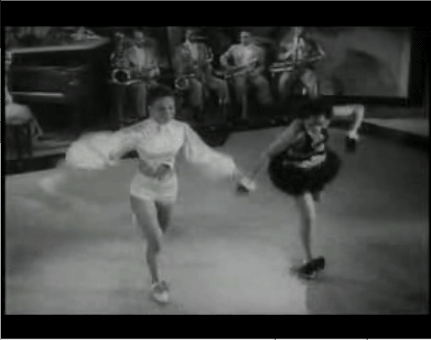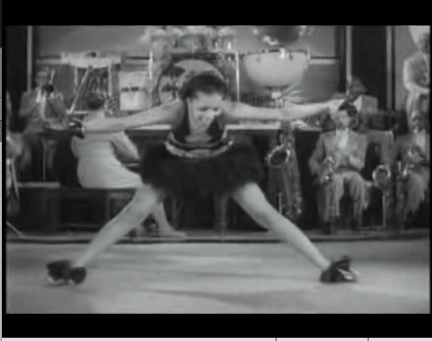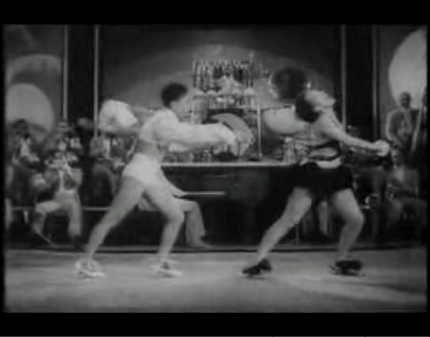Jazz that nobody asked for from Benny Box on Vimeo.
(c/o The Hub).
Happy International Women’s Day!
Today, a woman who particularly inspires/inspired me!
I was in this class with Sugar and Peter, and one morning early in the week Sugar self-corrected describing the leads as ‘he’ with the comment: “because these days girls lead too, and that’s alright!” I led in most of my classes that week, and she was one of the few teachers I’ve ever had who’s been so encouraging of women leads.
Oh, and she was also badass that week with the First Stops routine
…and of course, years ago!.
Man, this is a busy week.
Here’s a repost because I am busy.
In the 1935 film ‘Roberta’.
(I love the band in this scene!)
Crap! Nearly forgot to post!
Off to teach in a tick, so no time for more research.
First couple, dancing with Johnny Innis in A Day At The Races (1937):
Born Nannie Mayme in Lancaster, South Carolina in 1912, (passing away 3 May 1967), McKinney was a talented performer with a relatively short career. As with many of the big name black women stars of the period she could sing, dance, act, was a talented comedian… all that good stuff. She starred in Lew Leslie’s stage show Blackbirds of 1928, and there was discovered for the film Hallelujah!. She also starred in Safe in Hell (1931), Gang Smashers (aka Gun Moll 1938) The Devil’s Daughter (aka Pocomania 1939), and a number of other films (you can read more about those here).
There are some more excellent photos in Toms, Coons, Mulattoes, Mammies, and Bucks: An Interpretive History of Blacks in American Films By Donald Bogle, which is a key work in American race and film studies (it’s dealing in large part with racial stereotypes in cinema).)
See Nina Mae McKinney dancing and singing in this excerpt from the 1929 film Hallelujah!:
Golly, that last post was fierce.
You know you don’t really have to solo dance if you don’t want to, don’t you?
Best post over at VernacularJazzDance: So solo jazz – why bother?
This post really says it all. So I’ll just add some crap on the end.
Things I have seen in my weekly solo jazz class (which we’ve been teaching for a year now):
For myself, I’ve found teaching solo jazz weekly a real challenge. I’ve done my own independent solo dance work for years and years. But teaching it weekly has made the biggest difference to my dancing that I’ve ever seen, in fourteen years of lindy hop. Unlike lindy hop classes, when you’re teaching solo (as the blogpost at the top points out), you’re working damn hard all class. Usually at higher tempos. When we were doing the big apple over six weeks of classes (we are DAMN thorough in our teaching, my friends), I saw a crazy huge improvement in my own fitness, my abilities, and my memory.
Teaching solo dance requires different teaching skills. You have to remember that brand new students will not have the fitness or control that students who’ve been coming for a few weeks do, so they’ll be more likely to feel frustrated or disheartened if you don’t keep an eye on them. You have to break shit down really thoroughly, because students don’t have a partner to give them feedback.
In many cases, the students who’ve been doing lindy hop for a few years will actually have some pretty seriously bad habits that need to be broken. But this ‘breaking’ can really break a student’s self esteem if you’re not really careful. Many of the male leads in particular find it too confronting to suddenly discover that all their dancing ‘skills’ are actually dodgy habits which good follow turn into a workable dance. They find it really hard to start from scratch and be a beginner again. So you’ve gotta be gentle, but not patronising.
You don’t have all the changing partners and class interaction stuff to lift the energy in the room – you’ve got to keep people feeling happy and confident and good about themselves in other ways. You’ve got to provide the nice, friendly social vibe that partner dancing brings, but you gotta do it through other methods. I find that the solo classes develop a better sense of camaraderie (because we work as a team, not as a series of partnerships), but that it can be damn hard to maintain a good class vibe later in the evening when everyone’s tired and you’re dealing with challenging material. And if two of you are teaching, you have to find a way to develop a good to-and-fro and rhythm to your teaching-talk. Basically, teaching solo jazz dance and maintaining numbers, every single week, makes you a much better teacher.
Coming up with class content is also challenging. We get through stacks more material in a solo class than we do a lindy hop class, though we tend to average about three phrases in an hour. If we’re doing a historic routine, we have to transcribe it from the archival material (argh! the fuzzy black and white!). We usually cross-reference with other videos to be sure we’ve properly understood what we’re looking at. This takes AGES at the beginning, when your own repertoire is really small. But after a while, you start to recognise key rhythms and steps and shapes, and the transcribing goes faster. And by fuck you get a really good, thorough understanding of jazz dance vocabulary and history.
After you’ve written down the steps, you have to learn them. I mean really learn them. And then you have to figure out how to teach. If you’re a bullshit teacher you can just say “Do this!” and then do it a heap of times. But that’s not helpful. So you have to break the movement down into its constituent parts.
A suzi-q is really just a step step step, from right to left (and vice versa). What makes it a suzi-q is the way you then style that step. But you have to start with step-step-step to be sure the students have good weight changes. But you have to teach this concept in a really ‘natural’ way. You can’t make it into some sort of complicated algebra. You have to find ways of describing what you’re doing which everyone can identify with: walking, squatting as though you’re about to sit on a chair, etc etc etc.
And then you try that method on a class, see it fail dismally, and have to recover in real time. And then you rethink your approach later, so the next time you teach that move, you do a better job.
And on top of all that, you have to make sure that you’re actually doing what you’re saying, because students learn more from watching than they do from listening. So you’re going to need to spend an awful lot of time in front of a mirror or with a video camera.
But geez you’re gonna get good.
And then, after a few months of that, you get tired of just drilling students through routines. So you need other class content and structure. So you’re going to need to choreograph stuff. You’ll need to know how phrases work, how music works, and how to join steps together. It’s hard, especially at first. Then, after you’ve choreographed the damn thing, you have to memorise it. And then you have to share it with your partner (if you’re not choreographing together). More videoing.
These days, if someone tells me they don’t solo dance (for whatever bullshit reason) I know immediately that they are inexperienced or ignorant. You simply cannot be a decent lindy hopper without solo dance skills. And I don’t mean ‘good’, I mean decent. Because ‘solo dance skills’ are just dance skills. And if you can’t dance without hanging onto another person, you have a lot of growing up to do.
This has perhaps been the biggest impact of solo dance on my lindy hop. I teach lindy hop as if it were a solo dance first, and I build solo work into each class. As a necessity. There’s a lot of time spent in each of our classes working on rhythms, steps, balance, bounce, all that good stuff. And then we bring people together.
Solo dance because yolo. And anything that gives you a leg up in the lindy hop improvement stakes is worth its weight in gold, friends.
*Watching videos of my students perform solo routines makes me feel crazy proud. They are SO GREAT!
[EDIT: omg imagecreditFAIL. Props to FuckYeahSwingDance/vernacularjazzdance for the memalish. I totally stole her idea]
Cora LaRedd singing and dancing in the number ‘Jig Time’ with Noble Sissle’s Orchestra in the 1933 film That’s the Spirit.
She caught my eye because she has a really strong style, and she has darker skin, which is unusual in these films of black American women tap dancers of the period.
Here‘s an interesting photo story about African American women tap dancers.
You can read a bit about her in Constance Valis Hill’s book Tap Dancing America: A Cultural History on google books.
LaRedd, Cora Singer and dancer. Raised on Broome Street; Broadway musical star (late 1920s-early 1930s); appeared in Messing Around with music by James P.Johnson at New York’s Hudson Theater (1929) and Hamtree Harrington and Albert Hunter in Changer Your Luck (1930); in her heyday, known for splashing her money around; led band in New York at one point; toured Europe several times; when her star fell, returned to Newark, playing Golden Inn and other clubs; according to Herald News reviewer (1939), “fell into Dodger’s and had everyone in stitches with her funny exchanges… a real trooper”; deceased.
Joe Gregory: “In our eyes, she was a star.”
Wesley Clark: “She had a beautiful body; she danced like a man. She was tough – a top dancer to come out of Newark.”
Bill Roberts: “She was very much a black woman who lavished her money on younger men. That’s what took her down.”
Jonah Jones (The World of Swing): “We [Jimmie Lunceford’s band] had a chance to come to New York [from Buffalo] and try out for a job, but we missed it because a girl called Cora LaRedd (primarily a vocalist) had a band they liked better.”
– Swing City: Newark Nightlife, 1925-50
By Barbara J. Kukl
If you’re looking for more information about LaRedd, you could try looking in French newspapers and magazines and film reels in the 20s and 30s. Maybe see if you can pin down her French tour(s) first with some browsing of visas and things.
LaRedd was a Cotton Club dancer, and there’s a reference to her in Duke Ellington and His World, By A. H. Lawrenc placing her in a production called It’s the Blackberries on 29 Sep 1929.
A couple of sources credit her with the first release of the song ‘Truckin’ (eg Country: The Twisted Roots of Rock ‘n’ Roll, By Nick Tosche:
“Truckin'”, written by Ted Koehler (author of “Stormy Monday”) and Rube Bloom (author of “Fools Rush In”), was one of the most successful songs of 1935. A dance song full of whimsical sexual implications, it was introduced by Cora LaRedd in the twenty-sixth edition of the Cotton Club Parade at the Cotton Club in New York City, and was immediately recorded by many artists.”
I haven’t time for any more research, but if you’re curious, these tidbits should be enough to get you searching for playbills, magazine articles, reviews and footage from the period.
(another post I’ve just lifted from 2011 – late night, lots of DJing and dancing, feeling a bit too poop to be creative)
aka Mildred “Boogie” Pollard, aka Lindy hopper!
In Radio City Revels in 1938, Gibson’s in the second couple in the jam, but the first couple after the cut from the singer at the beginning (ie there’s another couple in the jam before Gibson and partner ‘Shorty’ Davis).
In Spirit Moves in 1950 with James Berry:
It’s women’s history month again, and I’m a bit slow off the mark (again).
The theme for the Australian Women’s History Month is ‘Finding Founding Mothers’, which is alright by me.
In 2011 I listed a different woman jazz dancer every day for WHM. And in 2012 I chose a different woman jazz musician. The musician one was hard, and didn’t really catch my interest. Because I’m so slack this year, I’m going to recycle my 2011 posts. And I’m going to look for more women, when I get time. There are just so many amazing women jazz dancers, it’s silly to just rehash the same 30. Especially when we need to remember MORE!
But for now, here are my two favourites. One for yesterday, and one for today, the 2nd March.
Florence Hill AND Bessie Dudley!
Here are some stills:




These are all stills from A Bundle of Blues, a short film starring Duke Ellington and his orchestra (including Ivie Anderson), Florence Hill and Bessie Dudley.
(linky)
I can’t confirm this, but apparently Bessie Dudley worked with Snake Hips Tucker, and he gave her a black eye for doing his act.
Here is a photo of Bessie Dudley with Snake Hips Tucker:
I don’t have time to do more research (I say this every single year), but Dudley was a dancer at the Cotton Club, so if you’re curious, you could start there.